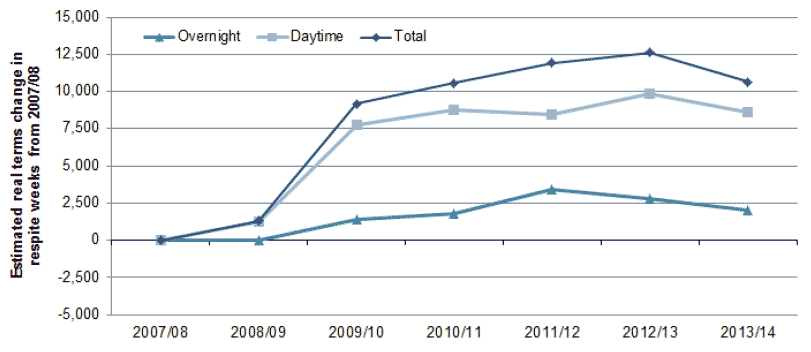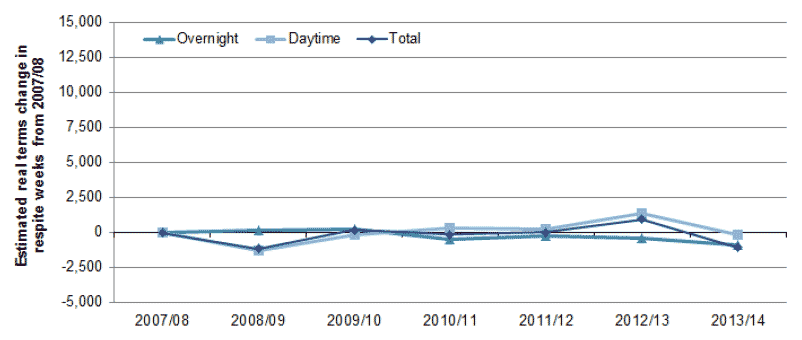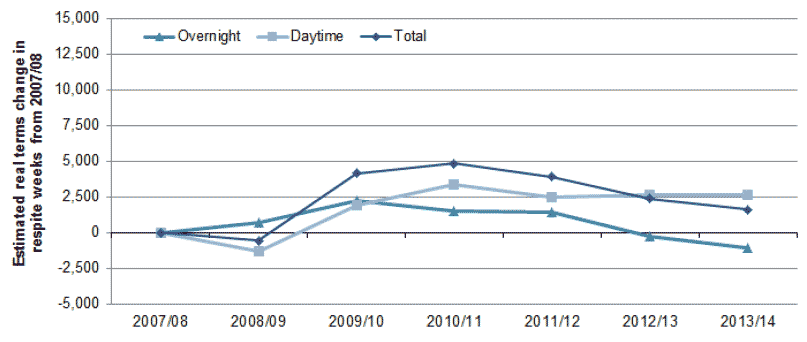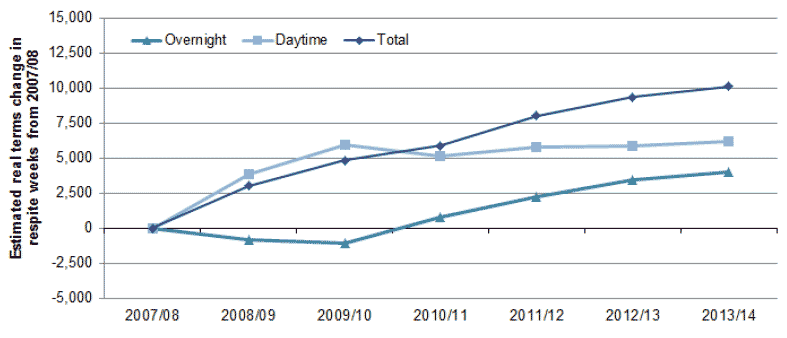Respite Care Scotland, 2014
Presents information on respite care services provided or purchased by Local Authorities in Scotland. Respite Care is a service intended to benefit a carer and the person he or she cares for by providing a short break from caring tasks.
4. Estimated real terms changes in overnight and daytime respite provision,
2007/08 to 2013/14
When comparing respite provision over the past seven years, only changes in recorded levels of overnight care and daytime care are considered. This is because information on respite care provided through Direct Payments; i) has only been available since 2012/13, and ii) remains incomplete in terms of national coverage.
Over the period since 2007/08 Local Authorities have been improving and refining their data collection methodologies. This means that two different sets of respite figures are presented for most years: i) a comparable figure based on the same methodology as the previous year; and ii) a figure based on the revised methodology, which is not comparable to previous years but comparable going forward. Using this approach has allowed Local Authorities to revise their methodologies, whilst still allowing for real terms changes in respite provision to be identified.
Diagram 1 shows how respite weeks data will be presented in this section of the Release. Over the period 2007/08 to 2013/14, there are five sets of comparable figures (denoted by superscript numbers 0 - 4), each associated with a defined set of national guidance. The comparable sets of figures can then be used to estimate the real terms differences year-on-year.
Diagram 1 - Example tabular presentation of respite week figures

Relatively greater care needs to be used if attempting to use the tabular format shown in Diagram 1 to estimate real terms changes over more than one year. Instead, charts such as Chart 1 may be used to visualize the estimated real terms changes in respite week provision across multiple years. Note that the vertical axes of these charts show the estimated cumulative real terms changes in respite weeks from 2007/08. A downward shift from one year to the next represents an estimated real terms decrease in respite weeks between those years, whereas a negative axis value represents an estimated real terms decrease from 2007/08.
The national guidance used to collect respite information from Local Authorities did not change between 2012/13 and 2013/14. As such, Authorities were only asked to return 2013/14 information on the basis of a single set of guidance. However, in the explanatory notes supplied with the data returns seven Authorities identified recording changes related to the roll-out of Self-Directed Support (SDS) and a further six identified specific improvements to their local recording systems over the past year (see Section 6.5 for further details). As a result, an additional degree of uncertainty is associated with making real terms comparisons of Scotland level respite provision between 2012/13 and 2013/14. The likely sense and potential magnitude of this uncertainty is considered in Section 6.5.
Only Scotland level analysis is presented in this section of the Release. Information on respite provision at the Local Authority level may be found in the Annexes. Additional care should be taken when interpreting year-to-year changes within this data, especially in the cases of the Authorities who have experienced known recording changes over the past year.
4.1 Respite weeks provided for the benefit carers of all age groups
The five different sets of comparable figures in Table 1 show an increase in combined overnight and daytime respite provision from 172,730 weeks in 2007/08 to 203,090 weeks in 2013/14. This is an apparent total increase of 30,360 weeks over this time period, of which it is estimated that 19,710 weeks are due to improved data recording and/or methodology changes and the remaining 10,650 weeks are due to a 6.2% real terms increase in respite provision.
Table 1 - Overnight and daytime respite weeks provided in Scotland, 2007/08 to 2013/14
| 2007/080 | 2008/090 | 2008/091 | 2009/101 | 2009/102 | 2010/112 | 2010/113 | 2011/123 | 2012/133 | 2012/134 | 2013/144 | |
|---|---|---|---|---|---|---|---|---|---|---|---|
| Overnight | 62,750 | 62,800 | 62,730 | 64,110 | 64,290 | 64,650 | 64,900 | 66,570 | 65,880 | 65,760 | 65,030 |
| Daytime | 109,980 | 111,230 | 132,980 | 139,460 | 145,510 | 146,570 | 138,820 | 138,500 | 139,920 | 139,320 | 138,060 |
| Total | 172,730 | 174,030 | 195,710 | 203,570 | 209,800 | 211,210 | 203,730 | 205,070 | 205,800 | 205,080 | 203,090 |
| % of respite (Daytime) | 64% | 64% | 68% | 69% | 69% | 69% | 68% | 68% | 68% | 68% | 68% |
Source: Audit Scotland SPI data 2007/08-2008/09, Scottish Government 2009/10-2013/14
Note: All respite weeks figures are rounded to the nearest ten.
At the year-to-year level, real terms increases in respite provision were estimated for every year up to 2012/13 (including a relatively large increase in 2009/10), followed by an estimated decrease over the past year. The estimated real terms changes between each year are as follows:
- increase of 1,300 weeks (0.8%) between 2007/080 and 2008/090
- increase of 7,860 weeks (4.0%) between 2008/091 and 2009/101
- increase of 1,410 weeks (0.7%) between 2009/102 and 2010/112
- increase of 1,340 weeks (0.7%) between 2010/113 and 2011/123
- increase of 740 weeks (0.4%) between 2011/123 and 2012/133
- decrease of 1,990 weeks (1.0%) between 2012/134 and 2013/144
In terms of understanding the origin of the estimated real terms decrease in respite provision over the past year, it is thought that the likely combined effect of the known recording changes is to mask a somewhat larger real terms decrease in service provision (for the reasons outlined in Section 6.5).
19 out of 32 Local Authorities recorded increases in their total overnight and daytime respite provision between 2012/13 and 2013/14, while 12 recorded decreases. It is not possible to make this comparison in the case of the Orkney Islands, as 2012/13 respite data for this Authority is not available (see Section 6.5). Of those Authorities recording increases, East Dunbartonshire and West Lothian recorded percentage increases of more than 10%. Of those Authorities recording decreases, Argyll & Bute and Glasgow City recorded percentage decreases of more than 10%. The largest recorded percentage decrease, of 23.2%, was that for Glasgow City. Given that Glasgow City is also the most populous Local Authority; it is unsurprising that the recorded decrease of 4,800 respite weeks is by far the largest of any Authority (the next largest being more than seven times smaller).
Recording changes related to the roll-out of Self-Direct Support to young people (aged 0-17) and adults aged 18-64 may have contributed to the large overall decrease recorded by Glasgow City (see Section 6.5). However, the decrease of 2,350 respite weeks associated with the care of older people (aged 65+) is not thought to have been affected by the roll-out of Self-Directed Support. The decrease recorded by Glasgow City for this cared-for age group remains larger than the Scotland level decrease seen across all cared-for age groups. The decrease in respite care provided for the benefit of carers of older people (aged 65+) in Glasgow City is known to be affected by; i) a reduction in the number and length of traditional overnight respite stays in Care Homes and; ii) with the introduction of day care charges, a number of service users opting to cease or reduce their day care hours.
Chart 6 shows that the estimated changes in total respite provision, including the relatively large increase in 2009/10, are mainly accounted for by the changes in daytime provision.
Chart 6 - Estimated changes in real terms overnight and daytime respite weeks provided in Scotland, 2007/08 to 2013/14

Source: Audit Scotland SPI data 2007/08-2008/09, Scottish Government 2009/10-2013/14
Note: Estimated real terms changes based on changes in methodology between years.
The number of daytime respite weeks provided in 2013/14 was 138,060, while the number of overnight weeks was 65,030. The balance of overnight to daytime care, with 68% being during the daytime, has remained around the same value since 2009/10, following an increase from 2007/08. This earlier increase is known to have been affected by methodology changes, as Local Authorities generally find it much harder to identify daytime respite.
4.2 Respite weeks provided for the benefit of the carers of young people (aged 0-17)
The five different sets of comparable figures in Table 2 show a decrease in combined overnight and daytime respite provided for the benefit of carers of young people (aged 0-17) from 23,950 weeks in 2007/08 to 22,060 weeks in 2013/14. This is an apparent total decrease of 1,890 weeks over the time period, of which it is estimated that 860 weeks are due to improved data recording and/or methodology changes and the remaining 1,030 weeks are due to a 4.3% real terms decrease in respite provision. This estimated percentage decrease in real terms respite provision from 2007/08 to 2013/14 is more than twice as large as the 1.6% decrease in the 0-17 aged population over the same period*.
Table 2 - Overnight and daytime respite weeks provided for the benefit of carers of young people (aged 0 to 17) in Scotland, 2007/08 to 2013/14
| 2007/080 | 2008/090 | 2008/091 | 2009/101 | 2009/102 | 2010/112 | 2010/113 | 2011/123 | 2012/133 | 2012/134 | 2013/144 | |
|---|---|---|---|---|---|---|---|---|---|---|---|
| Overnight | 7,850 | 8,000 | 8,050 | 8,200 | 8,200 | 7,470 | 7,450 | 7,670 | 7,470 | 7,760 | 7,320 |
| Daytime | 16,100 | 14,830 | 14,720 | 15,880 | 16,140 | 16,570 | 15,390 | 15,300 | 16,440 | 16,300 | 14,750 |
| Total | 23,950 | 22,830 | 22,770 | 24,080 | 24,340 | 24,040 | 22,830 | 22,970 | 23,900 | 24,060 | 22,060 |
| % of respite (Daytime) | 67% | 65% | 65% | 66% | 66% | 69% | 67% | 67% | 69% | 68% | 67% |
Source: Audit Scotland SPI data 2007/08-2008/09, Scottish Government 2009/10-2013/14
Note: All respite week figures rounded to the nearest ten.
At the year-to-year level, real terms increases are estimated for some years and decreases for others, including a relatively large decrease over the past year. The estimated real terms changes between each year are as follows:
- a decrease of 1,120 weeks (4.7%) between 2007/080 and 2008/090
- an increase of 1,310 weeks (5.8%) between 2008/091 and 2009/101
- a decrease of 300 weeks (1.2%) between 2009/102 and 2010/112
- an increase of 140 weeks (0.6%) between 2010/113 and 2011/123
- an increase of 940 weeks (4.1%) between 2011/123 and 2012/133
- a decrease of 2,000 weeks (8.3%) between 2012/134 and 2013/144
The relatively large year-to-year changes associated with this cared-for age group arise, at least in part, because it contains smaller numbers of clients with larger care packages than the adult cared-for age groupings. The transitioning of small numbers of young people (aged 0-17) clients in / out of this age group (e.g. transitioning out to adult services) can lead to relatively large changes to the recorded provision to the group as a whole.
In terms of understanding the estimated real terms decrease in respite provision over the past year, Section 6.5 outlines how the data related to young people (aged 0-17) is not generally affected by the known improvements to local recording systems. However, several Local Authorities who reported recording changes related to SDS roll-out stated that these changes could affect this data. The local system improvements tend to result in increased recording levels, whereas the SDS-related changes tend to result in decreased recording levels. As such, the estimated real terms decrease over the past year may be due, at least in part, to recording changes.
* Based on the National Records of Scotland mid-year population estimates (see Section 6.9).
Chart 7 shows that the changes in total estimated respite provision for the benefit of carers of young people (aged 0-17) are mainly accounted for by estimated changes to daytime provision. This chart has the same axis scaling as Chart 6, showing that the changes estimated for this cared-for age group do not generally account for a substantial component of the overall changes, with the exception of the decrease seen over the past year.
Chart 7 - Estimated changes in real terms overnight and daytime respite weeks provided for the benefit of carers of young people (aged 0 to 17) in Scotland, 2007/08 to 2013/14

Source: Audit Scotland SPI data 2007/08-2008/09, Scottish Government 2009/10-2013/14
Note: Estimated real terms changes based on changes in methodology between years.
The number of daytime weeks provided for the benefit of the carers of young people (aged 0-17) in 2013/14 was 14,750, while the number of overnight weeks was 7,320. The proportion of care that is delivered during the daytime (67% in 2013/14) has remained around the same value since 2007/08.
4.3 Respite weeks provided for the benefit of carers of adults aged 18-64
The five different sets of comparable figures in Table 3 show an increase in combined overnight and daytime respite provision for the benefit of carers of adults aged 18-64 from 59,050 weeks in 2007/08 to 72,540 weeks in 2013/14. This is an apparent total increase of 13,490 weeks over the time period, of which it is estimated that 11,900 weeks are due to improved data recording and/or methodology changes and the remaining 1,590 weeks are due to a 2.7% real terms increase in respite provision. The estimated percentage increase in real terms respite provision from 2007/08 to 2013/14 is slightly smaller than the 3.7% increase in the 18-64 aged population over the same period*.
Table 3 - Overnight and daytime respite weeks provided for the benefit of carers of adults aged 18-64 in Scotland, 2007/08 to 2013/14
| 2007/080 | 2008/090 | 2008/091 | 2009/101 | 2009/102 | 2010/112 | 2010/113 | 2011/123 | 2012/133 | 2012/134 | 2013/144 | |
|---|---|---|---|---|---|---|---|---|---|---|---|
| Overnight | 18,030 | 18,760 | 18,690 | 20,180 | 20,300 | 19,550 | 19,850 | 19,790 | 18,090 | 17,750 | 16,970 |
| Daytime | 41,020 | 39,700 | 50,380 | 53,620 | 56,650 | 58,090 | 57,790 | 56,920 | 57,080 | 55,560 | 55,560 |
| Total | 59,050 | 58,460 | 69,070 | 73,790 | 76,950 | 77,640 | 77,640 | 76,710 | 75,170 | 73,300 | 72,540 |
| % of respite (Daytime) | 69% | 68% | 73% | 73% | 74% | 75% | 74% | 74% | 76% | 76% | 77% |
Source: Audit Scotland SPI data 2007/08-2008/09, Scottish Government 2009/10-2013/14
Note: All respite weeks figures rounded to the nearest ten.
The estimated real terms changes in respite weeks represents increases for some years and decreases for others, including a relatively large increase in 2009/10 and a modest decrease over the past year. The estimated real terms changes between each year are as follows:
- a decrease of 590 weeks (1.0%) between 2007/080 and 2008/090
- an increase of 4,720 weeks (6.8%) between 2008/091 and 2009/101
- an increase of 690 weeks (0.9%) between 2009/102 and 2010/112
- a decrease of 930 weeks (1.2%) between 2010/113 and 2011/123
- a decrease of 1,540 weeks (2.0%) between 2011/123 and 2012/133
- a decrease of 760 weeks (1.0%) between 2012/134 and 2013/144
In terms of understanding the estimated real terms decrease in respite provision over the past year, Section 6.5 outlines how the data related to adults aged 18-64 is not generally affected by the known improvements to local recording systems. However, several Local Authorities who reported recording changes related to SDS roll-out stated that these changes could affect this data. The local system improvements tend to result in increased recording levels, whereas the SDS-related changes tend to result in decreased recording levels. As such, the estimated real terms decrease over the past year may be due, at least in part, to recording changes.
* Based on the National Records of Scotland mid-year population estimates (see Section 6.9).
Chart 8 shows that the estimated changes in total respite provision for the benefit of carers of adults 18-64 are accounted for by a mixture of the estimated changes to overnight and daytime provision. This chart has the same axis scaling as Chart 6, showing that the changes estimated for this cared-for age group account for substantial components of the overall increases in 2009/10 and 2010/11 and also of the overall decrease over the past year.
Chart 8 - Estimated changes in real terms overnight and daytime respite weeks provided for the benefit of carers of adults aged 18 to 64 in Scotland, 2007/08 to 2013/14

Source: Audit Scotland SPI data 2007/08-2008/09, Scottish Government 2009/10-2013/14
Note: Estimated real terms changes based on changes in methodology between years.
The number of daytime weeks provided for the benefit of carers of adults aged 18-64 in 2013/14 was 55,560, while the number of overnight weeks was 16,970. This cared-for age group has the highest proportion of respite that is provided during daytime (77% during 2013/14). This proportion has increased in most years since 2007/08, when it was 69%. These increases are known to have been affected by methodology changes, as Local Authorities generally find it much harder to identify daytime respite.
4.4 Respite weeks provided for the benefit of carers of older people (aged 65+)
The five different sets of comparable figures in Table 4 show an increase in combined overnight and daytime respite provision for the benefit of carers of older people (aged 65+) from 89,730 weeks in 2007/08 to 108,490 weeks in 2013/14. This is an apparent total increase of 18,760 weeks over the time period, of which it is estimated that 8,650 weeks are due to improved data recording and/or methodology changes and the remaining 10,110 weeks are due to an 11.3% real terms increase in respite provision. The estimated percentage increase in real terms respite provision from 2007/08 to 2013/14 is slightly larger than the 10.4% increase in the 65+ aged population over the same period*.
Table 4 - Overnight and daytime respite weeks provided for the benefit of carers of older people (aged 65+) in Scotland, 2007/08 to 2013/14
| 2007/080 | 2008/090 | 2008/091 | 2009/101 | 2009/102 | 2010/112 | 2010/113 | 2011/123 | 2012/133 | 2012/134 | 2013/144 | |
|---|---|---|---|---|---|---|---|---|---|---|---|
| Overnight | 36,870 | 36,040 | 35,990 | 35,740 | 35,790 | 37,620 | 37,610 | 39,120 | 40,330 | 40,250 | 40,740 |
| Daytime | 52,860 | 56,700 | 67,880 | 69,960 | 72,720 | 71,910 | 65,640 | 66,270 | 66,410 | 67,470 | 67,750 |
| Total | 89,730 | 92,740 | 103,870 | 105,700 | 108,510 | 109,530 | 103,250 | 105,390 | 106,730 | 107,720 | 108,490 |
| % of respite (Daytime) | 59% | 61% | 65% | 66% | 67% | 66% | 64% | 63% | 62% | 63% | 62% |
Source: Audit Scotland SPI data 2007/08-2008/09, Scottish Government 2009/10-2013/14
Note: All figures rounded to the nearest ten.
A real terms increase in respite provision for the benefit of carers of older people (aged 65+) has been estimated for each of the past six years, including a relatively modest one over the past year. The estimated real terms changes between each year are as follows:
- increase of 3,010 weeks (3.4%) between 2007/080 and 2008/090
- increase of 1,830 weeks (1.8%) between 2008/091 and 2009/101
- increase of 1,020 weeks (0.9%) between 2009/102 and 2010/112
- increase of 2,140 weeks (2.6%) between 2010/113 and 2011/123
- increase of 1,340 weeks (1.3%) between 2011/123 and 2012/133
- increase of 770 weeks (0.7%) between 2012/134 and 2013/144
In terms of understanding the estimated real terms decrease in respite provision over the past year, Section 6.5 outlines how known improvements to local recording systems generally affect the data related to older people (aged 65+). In contrast, recording changes related to SDS roll-out are not generally reported to affect this data. The local system improvements tend to result in increased recording levels, whereas the SDS-related changes tend to result in decreased recording levels. As such, it is at least possible that the estimated real terms increase in respite provision over the past year may be due, at least in part, to improvements in local recording systems.
* Based on the National Records of Scotland mid-year population estimates (see Section 6.9).
Chart 9 shows that the estimated past changes in total respite provision for the benefit of carers of older people (aged 65+) arise from a mixture of the estimated changes to overnight and daytime provision. This chart has the same axis scaling as Chart 6, showing that the changes estimated for this cared-for age group account for substantial components of the overall increases seen between 2008/09 and 2012/13.
Chart 9 - Estimated changes in real terms overnight and daytime respite weeks provided for the benefit of carers of older people (aged 65+) in Scotland, 2007/08 to 2013/14

Source: Audit Scotland SPI data 2007/08-2008/09, Scottish Government 2009/10-2013/14
Note: Estimated real terms changes based on changes in methodology between years.
The number of daytime weeks provided for the benefit of carers of older people (aged 65+) in 2013/14 was 67,750, while the number of overnight weeks was 40,740. This cared-for age group has the lowest proportion of respite that is provided during daytime (62% in 2013/14). This proportion has generally decreased since a maximum of 67% in 2009/10.
Contact
Email: Steven Gillespie
There is a problem
Thanks for your feedback